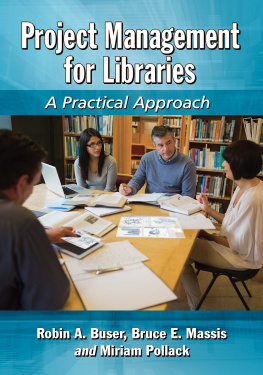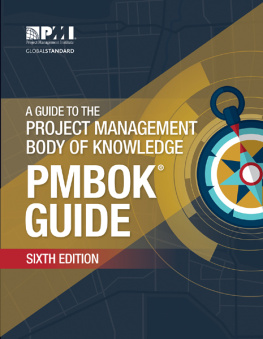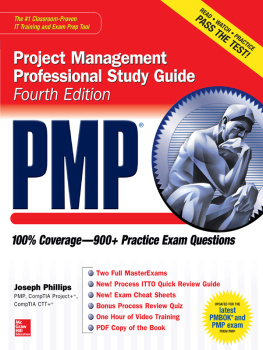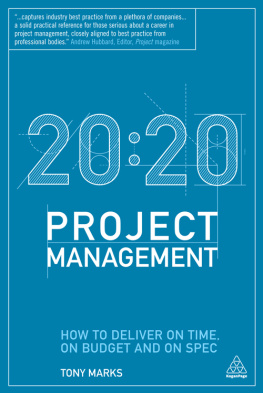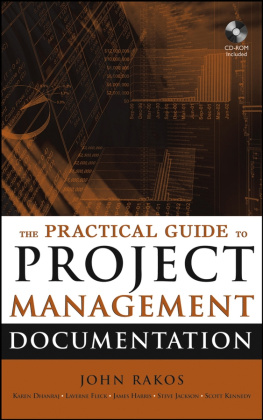
Project Management for Libraries
A Practical Approach
Robin A. Buser
Bruce E. Massis
Miriam Pollack

McFarland & Company, Inc., Publishers
Jefferson, North Carolina
LIBRARY OF CONGRESS CATALOGUING DATA ARE AVAILABLE
BRITISH LIBRARY CATALOGUING DATA ARE AVAILABLE
e-ISBN: 978-1-4766-1765-7
2014 Robin A. Buser, Bruce E. Massis and Miriam Pollack. All rights reserved
No part of this book may be reproduced or transmitted in any form or by any means, electronic or mechanical, including photocopying or recording, or by any information storage and retrieval system, without permission in writing from the publisher.
Cover: 2014 Wavebreak Media/Thinkstock
McFarland & Company, Inc., Publishers
Box 611, Jefferson, North Carolina 28640
www.mcfarlandpub.com
Preface
Project management is the controlled process that brings about a change in an organization and what it offers, based on a strategic direction. It can be highly structured or more informal. It uses defined objectives and is framed by a set of defined constraints. When done well, project management processes will have a positive impact on an organization, its staff and the people that it serves.
The Need for This Book
Librarians as influencers must be willing to embrace and understand project management in order to change and improve their libraries and what they offer to their users. Libraries once possessed warehouses of information that community members can now find at the press of a button on laptops and other electronic devices. Librarians should be trying to entice library users to take advantage of library services, rather than limiting community use. Many people view project management, with all its steps and documentation, as standing in the way of managing progress, but the truth is that using this methodology serves more to support progress than to limit it.
Many have entered the library profession because of a combination of extraordinary intellectual curiosity, devotion to the written word, social consciousness and exceptional organization skills. With such a worthy skill set in place, the project management methodology presents ample opportunities to capitalize on an established set of principles that can serve the profession well. The steps within project management are logical, methodical, specific and measurable. Assignment of duties and responsibilities, timelines, benchmarks and reporting provide a roadmap for success in library projects.
Librarians are faced with many small and large projects, and learning to effectively manage those projects will help you work more effectively and achieve goals. The economic condition of the country will always reflect cyclical booms and busts, but the demands on library administrators to bring in a project under time and under budget will always be the expectation, whether these expectations come from the library board, the public, the legislators or the press. It is important for the library to deliver a project using an effective technique so that a blueprint for success can be developed, followed and completed.
The economic downturn and continuing budget concerns have libraries, publishers and vendors making strategic changes in order to provide a high level of services while uncertainty continues to dominate planning and development. Librarians have embraced the electronic world, creating strategies that move from a print-based model to a model full of electronic books and databases, and the devices that support them.
Library work often involves coordinating projects with many tasks and many stakeholders where cost and time limitations can be seen as opportunities. Project management can serve librarians well in their approach to a project, not by imposing a strict regimen of needless steps, details and documentation upon the project team, but as a roadmap to ensure quality throughout the project, leading to its success.
Projects are often implemented without proper planning and when they do not work out as planned or fail completely, the project team is left to explain what happened and why. There are many reasons why a project fails. Common reasons are poor or absence of short and long term planning, inadequate resources (both human and otherwise), failure to pre-determine the risks and poor communication. Its not uncommon for projects to fail in any organization. A high rate of failure has been documented in the software industry, on construction projects, and in many other organizations, not just libraries. Calleam Consulting, a British organization, maintains a Catalogue of Catastrophe of noteworthy troubled projects from around the world.
In a prolonged economic downturn it is critical that libraries remain open and viable and that the projects initiated have the best opportunity to be successful. The current financial situation has caused many libraries to look carefully at plans and potential projects. The scrutiny that surrounds all organizations will remain at a heightened level and project transparency will be crucial, even once the economy improves. The transparency of a project and the importance of those viewing the use of project funds, both internally and externally, can best show that the project chosen was done so in the best interests of the stakeholders and that its outcomes meet the highest expectations for success. If all entities are satisfied that the level of responsibility by the stakeholders has met its mandate, then no charges can be leveled against the project team for performing in an irresponsible manner.
The purpose of this book, then, is to provide library staffers at every level, whether they are in a public, academic, school, or special library, with an understanding of the basic tools of project management methodology so that they may embark on projects with the expectation of success. Whether the project involves technology, program planning, staff evaluation, marketing, or any other endeavor, acquiring strong project management skills will enable the library to achieve a successful project that is on time, on budget and on goal. Determining whether a project was successful is not easy because there are numerous perspectives on success. These perspectives are important considerations for a complex and usually changing project:
1.Desired outcomes and results listed in the project agreement are achieved
2.The librarys problem is solved
3.The project is finished on time and within budget
4.The project team and the library sustain a high-quality working relationship
5.The library staff learns to address similar problems by themselves in the future.
Audience
The authors have prepared this material to suggest real-world applications of project management, not everyday operational work that simply keeps library doors open, but to projects that often suggest new, enhanced or additional services with an eye toward providing the most effective return on investment. It is intended that the methodology be used in a flexible and agile manner for the best application to each project.
This book is intended to help librarians who have been named project managers use professional processes to complete a project. It is also intended to help library administrators, potential project sponsors, understand the basics of project management in order to support their project managers.
The Organization of This Book
Next page
